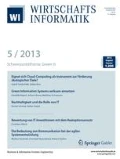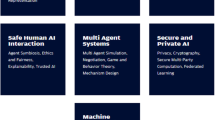Abstract
This article describes the actual applications of XML in the context of Business- Intelligence-Systems (BI). The potentials and synergies of XML and BI will be emphasized.
-
▪
XML applications can be found within all levels of BI-systems.
-
▪
The application of core-standards will be introduced as well as the possibilities of BI specific-standards.
-
▪
The discussion of the impact of XML for BI-systems follows along the dimensions: externalisation, integration, standardisation and rationalization.
Similar content being viewed by others
Literatur
Bange, C. et al.: OLAP und Business Intelligence. 7 Multidimensionale Datenbanken und 16 Business-Intelligence-Frontends im Vergleich. Oxygon, Feldkirchen 2003.
Bornhoevd, C.: Data Transformation for Warehousing Web Data. In: Diskussionspapier, Technische Universität Darmstadt, 2001.
The Business Process Management Initiative. BPML/BPEL4WS — A Convergence Path toward a Standard BPM Stack. In: http://www.bpmi.org/downloads/BPML-BPEL4WS.pdf, 2002-08-15.
Chang, D. T.: CWM Enablement Showcase: Warehouse Metadata Interchange Made Easy Using CWM. In: CWM White Paper, 2001.
Cover, R.: Xyleme Project: Dynamic Warehouse for XML Data of the Web. In: http://xml.coverpages.org/xyleme.html, 2002-03-24.
Dexter, D.: Investing in XML. In: http://www.sqlmag.com, 2001-02-13.
Data Mining Group: PMML 2.0 — General Structure of a PMML Document. In: http://www.dmg.org/v2-0/GeneralStructure.html, Abruf am 2002-07-17.
Feßenbecker, M.: ebXML fasst auch in Europa Fuß, In: http://www3.computerwoche.de/heftarchiv/2003/20030124/a80110872.html, 2003-01-24.
Gajewski, T.; Klement, T.: Generierung eines multidimensionalen Katalogsystems mit Datawarehouse-Architektur. In: GMD — Forschungszentrum Informationstechnik, Sankt Augustin 2000.
Gluchowksi, P.: Business Intelligence — Konzepte, Technologien und Einsatzbereiche. In: Hildebrand, K. (Hrsg.): HMD — Praxis der Wirtschaftsinformatik 222 (2001), S. 5–15.
Grimes, S.: XML for Analysis Decoded. In: http://www.intelligententerprise.com, 2001-08-31.
Grothe, M. et. al.: Business Intelligence — Aus Informationen Wettbewerbsvorteile gewinnen, Addison-Wesley Verlag 2000.
Harde, G.: XCube: Konzept zur XML-basierten Beschreibung von Datenwürfeln zur Realisierung eines förderativen Data-Warehouse-Netzwerks. In: Oldenburger Forschungsund Entwicklungsinstitut für Informatik-Werkzeuge und Systeme, http://www-is.informatik.uni-oldenburg.de/publications/244.pdf, 2001.
Hermiz, K.: PMML: Laying the Groundwork. In: http://www.db2mag.com/db_area/archives/2000/q4/miner.shtml, 2000.
Inria.: Integration of data and knowledge distributed over the web. In: http://www.inria.fr/recherche/equipes/gemo.en.html, Abruf am 2003-10-14.
Iyengar, S. et al.: Common Warehouse Model Specification Version 1.1. In: http://www.omg.org/cgi-bin/doc?ad/CWM03_200303-03-02.pdf, 2003-03-03.
Jeckle, M.: Scriptum zur Vorlesung XML. In: http://www.jeckle.de/vorlesung/script.html, 2002-05-08.
King, B.: XML for Analysis: A sneak peak inside the skunk works. In: DM Review 13 (2003) 5, S. 36–37.
Klettke, M.; Meyer, H.: XML und Datenbanken — Konzepte, Sprachen und Systeme, dpunkt Verlag 2003.
Kranich, P.; Schmitz, H.: Die Extensible Business Reporting Language. Standard, Taxonomien und Entwicklungsperspektiven. In: Wirtschaftsinformatik 45 (2003) 1, S. 77–80.
Kumar, R.: XML Standards for Global Customer Information Management. In: http://www.dmreview.com/master.cfm?NavID=193&EdID=5125, Mai 2002.
Mangisengi, O. et al.: Meta-Cube-X: An XML Metadata Foundation for Interoperability Search among Web Warehouses. In: Proceedings of the InernationalWorkshop on Design and Management of DataWarehouses, Interlaken 2001.
Means, W.; Harrold, E.: XML in a Nutshell, O’Reilly, Cambridge, Farnham, et al. 2001.
Microsoft Corp., Hyperion: XML for Analysis Specification — Version 1.0. In: http://www.essbase.com/downloads/XML_Analysis_spec.pdf, 2001-04-24.
Mignet, L., et al.: Acquiring XML pages for a WebHouse, In: http://citeseer.nj.nec.com/cache/papers/cs/26781/http:zSzzSzwww.cs.toronto.eduzSz~mignetzSzPublicationszSzb-da2000-acq.pdf/mignet00acquiring.pdf, 2000-07-23.
OASIS Cover Pages: Core-Standards for Markup Language Technologies. In: http://xml.coverpages.org/coreStandards.html, 2002-07-12.
Pendse, N.: The OLAP Report — Commentary: OLAP API wars. In: http://www.olapreport.com/products/APIs.htm, 2001-04-23.
Plotkin, D.: Building the XML Repository. In: http://www.intelligenteai.com/XMLRepository2/index.htm, Abruf am 2002-05-26.
Poole, J.: Model-Driven Architecture. In: Hyperion Solutions Position Paper ECOOP 2001, April 2001.
Riis, K.; Pedersen, D.: Using XML in OLAP Queries. In: Master’s Thesis, Aalborg University, 2001.
Sattler K. U. et al.: Metadaten und Datenqualität, Seminar Data Warehousing. Universität Magdeburg. In: http://wwwiti.cs.unimagdeburg.de/iti_db/lehre/dw/dw08.pdf, Abruf am 2002-08-18.
Scheuferle, W.: XML-KM. XML-basierte Mediatoren für Wissensextraktion und Brokering. In: http://www.darmstadt.gmd.de/oasys/projects/xmlkm, Abruf am 2002-08-10.
Schirp, G.: Anforderungsanalyse im Data-Warehouse-Projekt: Ein Erfahrungsbericht aus der Praxis. In: Hildebrand, K. (Hrsg.): HMD — Praxis der Wirtschaftsinformatik 222, 2001, S. 81–87.
Seligman, L.; Rosenthal, A.: XML’s Impact on Databases and Data Sharing. In: IEEE, Juni 2001, S. 59–67.
Spofford, G.: Access to Intelligence — The new OLAP APIs. In: http://www.intelligententerprise.com/020917/515feat2_1.shtml, 2002-09-17.
Sweeney-Coolidge, J.: Business Intelligence Market Primed for web services. Hurwitz Trend Watch — Data Warehousing and Business Intelligence, Hurwitz Group. In: http://research.hurwitz.com/getpdf.aspx?docid=466, 2001-05-31.
Totok, A.: Modellierung von OLAP-und Data-Warehouse-Systemen. Deutscher Universitäts-Verlag, Wiesbaden 2000.
World Wide Web Consortium (W3C) — Semantic Web. In: http://www.w3c.org/2001/sw, Abruf am 2002-07-17.
World Wide Web Consortium (W3C) — Recommendations. In: http://www.w3.org/TR/#Recommendations, Abruf am 2003-10-13.
White, C.: The Federated Data Warehouse. In: http://www.datawarehouse.com/iknowledge/articles/article.cfm?ContentID=168, 2000-08-14.
XBRL Deutschland: Informationen zu XBRL. In http://www.xbrl-deutschland.de/xg_information.htm,. 2002-09-12.
XML for Analysis Press Release — Microsoft, Hyperion welcomes SAS as Co-Chair on XML for Analysis Council. In: http://www.xmla.org/pr1.asp, 2002-04-08.
Zaiane, O. R. et al.: Immersed Visual Data Mining: Walking The Walk, Department of Computer Science, University of Alberta, Canada. In: http://www.cs.ualberta.ca/~ayman/Docs/zaianeBNCOD17.pdf, 2001.
Author information
Authors and Affiliations
Rights and permissions
About this article
Cite this article
Schwalm, S., Bange, C. Einsatzpotenziale von XML in Business-Intelligence-Systemen. Wirtschaftsinf 46, 5–14 (2004). https://doi.org/10.1007/BF03250991
Issue Date:
DOI: https://doi.org/10.1007/BF03250991




